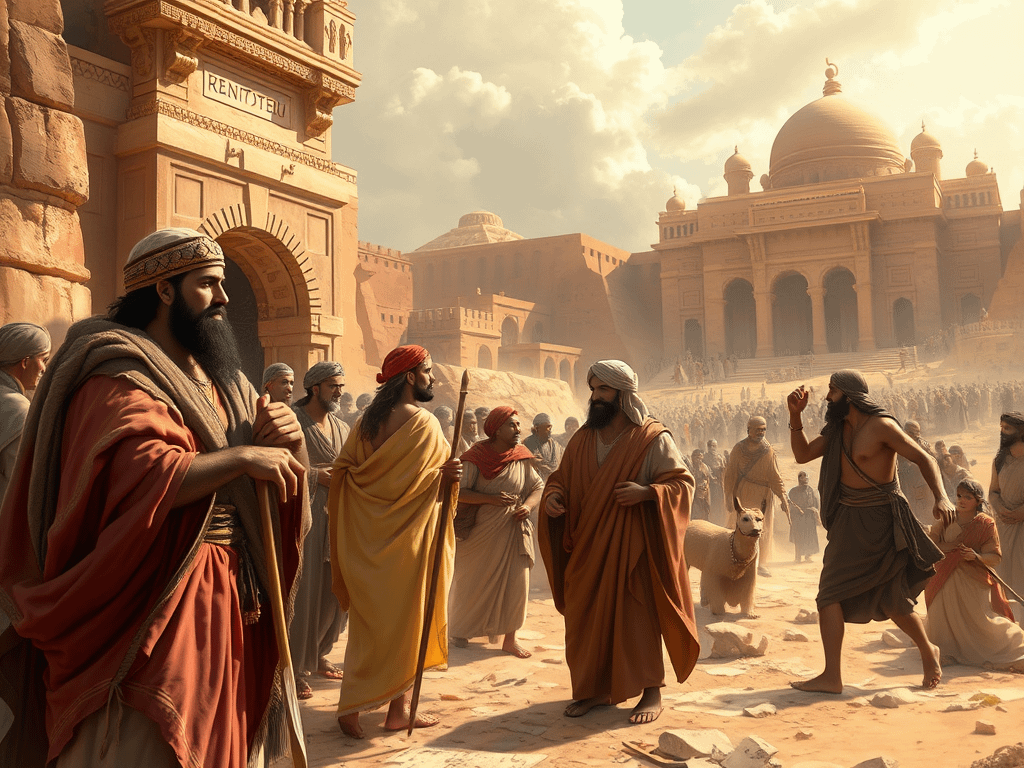Who was Daniel in the Bible?
Who was Daniel in the Bible? Who was Daniel, and why does his story continue to captivate readers around the world? Examining Daniel’s life and experiences offers profound insights into divine faith, prophecy, and perseverance.
The Book of Daniel, a part of both the Hebrew Bible and the Christian Old Testament, is a compelling narrative that intricately binds history, prophecy, and divine visions.
Let us journey through this biblical saga, exploring its various dimensions and implications.
Historical Context of Daniel
Daniel’s story unfolds during a tumultuous time in Jewish history, under Babylonian exile in the 6th century BCE. The Babylonian Empire, led by King Nebuchadnezzar II, conquered Jerusalem and took many Israelites captive.
Among them were Daniel and his three friends: Hananiah, Mishael, and Azariah. They were selected for their wisdom and potential to serve in the king’s court, a testament to their notable capabilities even in captivity.
| Event | Year | Significance |
|---|---|---|
| Nebuchadnezzar’s Conquest | 605 BCE | Beginning of Jewish exile |
| Daniel Interprets Dreams | 604 BCE | Rise to prominence in Babylon |
| Fiery Furnace | 602 BCE | Test of faith for Daniel’s friends |
| Daniel in the Lion’s Den | 538 BCE | Divine protection and deliverance |
Daniel and his friends faced the challenge of maintaining their religious identity in a foreign culture. Despite their new environment, they remained firm in their faith, refusing to defile themselves with the king’s food and drink.
This act of defiance set the stage for their subsequent divine favor and wisdom, marking Daniel and his friends as distinct and blessed among their peers.
Daniel’s Prophetic Visions
The Book of Daniel is unique for its apocalyptic visions, which have intrigued scholars and theologians for centuries. These visions, presented in vivid imagery and symbolism, foreshadow events far beyond Daniel’s time.
Notably, the vision of the statue composed of various materials symbolizing successive empires is pivotal.
In one of his dreams, Daniel sees a colossal statue made of gold, silver, bronze, iron, and clay. This vision is a representation of the sequence of world powers from Babylon to Rome.
Daniel interprets the dream as a prophetic timeline of kingdoms that would rise and fall before the divine establishment of God’s eternal kingdom. This aspect of the narrative provides a critical cornerstone for eschatological studies.
“Daniel answered and said, ‘Blessed be the name of God forever and ever, to whom belong wisdom and might.’”
Daniel’s Role in Babylonian Court
Young, but brimming with wisdom, Daniel’s role within the Babylonian court expanded rapidly due to his ability to interpret dreams and visions.
He garnered favor with King Nebuchadnezzar through his interpretative skills, particularly by revealing the king’s dreams, which involved complex symbols and messages from God.
These interpretations served not only as divine revelations but also as testimonies of God’s sovereignty and Daniel’s faithfulness.
Daniel’s prominence in the court illustrated how one’s steadfast dedication and spiritual resilience could yield favor even amidst an oppressive environment.
Through these narratives, the text reveals that divine wisdom surpasses temporal might, as even a captive could influence an empire’s rulers.
The Fiery Trial: Faith Tested in Nebuchadnezzar’s Reign
The story of Shadrach, Meshach, and Abednego—Daniel’s friends—in the fiery furnace underscores the themes of faith and divine intervention.
When commanded to bow to an image erected by Nebuchadnezzar, they refused, asserting their loyalty to God.
Their subsequent deliverance from the fire, without harm, was an exhibition of unwavering faith and a testament to God’s miraculous power.
This narrative reinforces the biblical ideal of standing firm in one’s beliefs, regardless of the external pressures or consequences.
It highlights God’s protection over His faithful, instilling courage in those who face trials for their beliefs.
- Faith as a resilience force.
- The potential of divine intervention.
- The consequences of obedience to faith.
- The testimony of God’s power through trials.
The Challenges of Cultural Integrity
Maintaining cultural and religious integrity in a foreign land forms a core theme in the Book of Daniel.
Daniel and his friends constantly navigated the crossroads between integrating with Babylonian norms and remaining true to their ancestral faith.
They were often placed in situations where their loyalty to God was tested, such as abiding by dietary laws or worship practices contrary to decree.
Their success in preserving their faith and identity illustrates the power of inner strength and commitment to one’s beliefs, even in assimilation-prone environments.
The narrative stresses that such faithfulness receives divine acknowledgment and blessing, both in the past and present contexts.

Interpretation of King Belshazzar’s Demise
Daniel’s interpretation of King Belshazzar’s doom is another pivotal moment in the biblical narrative. During a grand feast, daunting handwriting appeared on the palace wall.
Daniel deciphered the message, predicting the kingdom’s downfall due to Belshazzar’s hubris and sacrilege.
This incident underscores the theme of divine justice, proclaiming the downfall of conceit and impiety.
Daniel’s ability to deliver God’s message serves as both a warning and a reminder of divine oversight. The subsequent fall of Babylon reveals that human pride has limits and consequences that must be acknowledged.
Daniel in the Den of Lions
The account of Daniel in the lion’s den is perhaps one of the most well-known stories from the entire Bible.
Under King Darius, Daniel ascends to prominence, evoking envy among peers. Accusations led to his punishment of being thrown into a den of lions.
Despite this, Daniel’s faith was unwavering, and God protected him throughout the perilous night.
The miracle of Daniel’s safety is celebrated as a profound act of divine provision and reinforcement of fidelity. Daniel’s steadfastness serves as an inspiration for believers to trust in God’s power, no matter the circumstances they face.
Apocalyptic Revelations and Symbolism
The latter chapters of Daniel explore apocalyptic themes with profound symbolism, where heavenly beings convey messages concerning the end times.
These rich, symbolic visions extend into the realm of Christian eschatology, allowing interpretive insights into future events and divine intervention.
Daniel’s visions cast long shadows, shaping theological discourse on eschatology within Judeo-Christian traditions.
These revelations continue to inspire interpretation, inviting constant reflection on divine orchestration of historical and future events.
The Influence of Daniel’s Story Through History
Daniel’s tale has been revered throughout history as a powerful narrative of faith and divine wisdom.
His story highlights the constant interaction between divine will and human agency, providing a template for navigating life’s adversities. In Jewish tradition, Daniel is revered for his righteousness and insight.
Christian interpretations celebrate him for being a precursor to Christ, embodying qualities of faith and prophecy.
The narrative of Daniel has inspired countless generations in varied ways, from theological discourse to cultural adaptations in art, literature, and film, demonstrating timeless resonance with universal themes of faith, courage, and triumph over adversity.
Theological Significance and Lessons
The Book of Daniel remains a cornerstone of theological teaching and reflection. Its emphasis on divine fidelity, integrity in belief, and the ultimate sovereignty of God underscores many religious teachings.
The stories within Daniel provide powerful parables about living a faithful life despite external pressures and challenges.
Believers are encouraged to take lessons from Daniel’s unswerving trust in God, emulating his example of righteousness and reliance on divine wisdom.
The text teaches that steadfast faith and righteousness are rewarded, and divine justice prevails over worldly injustice.
Conclusion
The narrative of Daniel is a profound exploration of faith in the face of adversity, divine prophecy, and cultural resilience.
His story offers enduring lessons on the power of steadfast faith, the impact of divine wisdom, and the inevitability of divine sovereignty over worldly powers.
As an abiding cultural and religious icon, Daniel’s life provides insights into maintaining spiritual integrity within diverse and challenging contexts, encouraging contemporary audiences to draw inspiration from his example.
FAQ – Common Questions
Who was Daniel in the Bible?
Daniel was a Jewish noble taken captive by Babylonians and later served as a prominent advisor under several kings due to his ability to interpret dreams and visions.
What are some key events in Daniel’s story?
The fiery furnace, the interpretation of Nebuchadnezzar’s dreams, Belshazzar’s banquet writing, and Daniel’s ordeal in the lions’ den are notable events.
What do Daniel’s visions represent?
Daniel’s visions typically represent prophetic messages about future kingdoms and the establishment of God’s eternal kingdom, often intertwined with apocalyptic symbolism.
How does Daniel’s story end?
Daniel’s story concludes with his continued faithfulness and prophetic revelations about the end times, showing the interplay of divine power and human perseverance.
Why is the Book of Daniel important?
The Book of Daniel is important for its prophetic visions, lessons of faith, and its historical context during the Jewish exile in Babylon, influencing both Jewish and Christian eschatology







